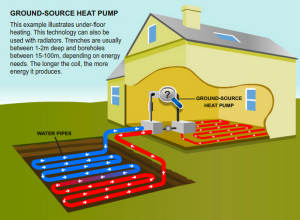Ground Source Heat Pumps

Heat your home with energy from the ground
 Ground source heat pumps make use of a piping loop which are buried in the garden to extract heat from the ground. This heat can then be used to heat radiators, underfloor or warm air heating systems and hot water in your home.
Ground source heat pumps make use of a piping loop which are buried in the garden to extract heat from the ground. This heat can then be used to heat radiators, underfloor or warm air heating systems and hot water in your home.
A ground source heat pump circulates a mixture of water and antifreeze around a large pipe – called a ground loop – which is buried in your garden. Heat from the ground is absorbed into the fluid and then passes through a heat exchanger into the heat pump.
The length of the ground loop depends on the size of your home and the amount of heat you need. Longer loops can draw more heat from the ground, but need more space to be buried in. If space is limited, a vertical borehole can be drilled instead.
The Benefits
Ground source heat pumps (also known as GSHPs):
- could lower your fuel bills, especially if you replace conventional electric heating
- can provide you with an income through the government’s Renewable Heat Incentive (RHI)
- could lower your home’s carbon emissions, depending on which type of heating fuel you are replacing
- reduce or even eliminate reliance on fuel deliveries
- can heat your home and provide hot water
- need little maintenance – they’re called ‘fit and forget’ technology.
Unlike gas and oil boilers, heat pumps deliver heat at lower temperatures over much longer periods. During the winter they may need to be on constantly to heat your home efficiently. You will also notice that radiators won’t feel as hot to the touch as they might do when you are using a gas or oil boiler. However this sustained constant temperature is better for your environment and fuel bills no spikes as you fiddle with a thermostat when you get home from work.
Air source heat pumps are usually easier to install than ground source as they don’t need any trenches or drilling, but they can have lower heat yields than GSHPs. Water source heat pumps can be used to provide heating in homes near to rivers, streams and lakes.
How do ground source heat pumps work?
A system of pipes (called a ground loop) is buried underground. This loop is filled with a fluid mixture called refrigerant, this fluid has a very low reactive temperature meaning it will evaporate even in temperatures of as low as -25°C. The pipes are buried at a level where the ground has a fairly consistent temperature higher than that of above the surface. The temperature causes the fluid to evaporate which means it will absorb the ambient heat energy of the ground. The fluid, now in a heated vapor form, is passed through a compressor which helps raise the temperature of the vapor. The vapor is then passed through a heat exchanger which transfers the heat from the refrigerant vapor to a suitable heat storage system, ie a hot water tank. The cooling refrigerant vapour is allowed to expand and condense and then it is passed back into the reservoir to begin the process again.
In most cases a ground loop would be laid flat or coiled in a trench about 2 metres deep. However, if space is an issue then a vertical loop can be installed with a depth of up to 100m in a typical domestic property. Heat pumps have some impact on the environment as they need electricity to run, but the heat they extract from the ground, the air, or water is constantly being renewed naturally.
Is a ground source heat pump suitable for me?
- Is your garden suitable for a ground loop? It doesn’t have to be particularly big, but the ground needs to be suitable for digging a trench or a borehole and accessible to digging machinery.
- Is your home well insulated? Since ground source heat pumps work best when producing heat at a lower temperature than traditional boilers, it’s essential that your home is insulated and draught-proofed well for the heating system to be effective. This is highly recommended practice for everyone as changes like this can dramatically affect your fuel bills.
- What fuel will you be replacing? The system will pay for itself much more quickly if it’s replacing an electricity or coal heating system. Heat pumps may not be the best option for homes using mains gas.
- What type of heating system will you use? Ground source heat pumps can perform better with underfloor heating systems or warm air heating than with radiator-based systems because of the lower water temperatures required.
- Is the system intended for a new development? Combining the installation with other building work can reduce the cost of installing the system.
You may also want to consider air source heat pumps, which extract heat from the outside air.
Costs, savings and earnings
Costs
Installing a typical system costs around £9,000 to £17,000. Running costs will depend on a number of factors – including the size of your home and how well insulated it is.
Savings
How much you can save will depend on what system you use now, as well as what you are replacing it with. Your savings will be affected by:
- Your heat distribution system If you have the opportunity, underfloor heating can be more efficient than radiators because the water doesn’t need to be so hot. If underfloor heating isn’t possible, use the largest radiators you can. Your installer should be able to advise on this.
- Your fuel costs You will still have to pay fuel bills with a heat pump because they are powered by electricity, but you will save on the fuel you are replacing. If the fuel you are replacing is expensive you are more likely to make a saving.
- Your old heating system If your old heating system was inefficient, you are more likely to see lower running costs with a new heat pump.
- Water heating If the heat pump is providing hot water then this could limit the overall efficiency. You might want to consider Solar water heating to provide hot water in the summer and help keep your heat pump efficiency up.
- Using the controls Learn how to control the system so you can get the most out of it. You will probably need to set the heating to come on for longer hours, but you might be able to set the thermostat lower and still feel comfortable. Your installer should explain to you how to control the system so you can use it most effectively.
These are the savings you might make every year when replacing an existing heating system in an average three-bedroom semi-detached home with a typical GSHP installation and a good installation:
Earnings
You may be able to receive payments for the heat you generate using a heat pump through the government’s Renewable Heat Incentive (RHI).
Maintenance
Heat pump systems typically come with a 10 year warranty. You can expect them to operate for 20 years or more, however they do require regular scheduled maintenance. A yearly check by you and a more detailed check by a professional installer every 3-5 years should be sufficient. The installer should leave written details of any maintenance checks you should undertake to ensure everything is working properly. Consult with your supplier for exact maintenance requirements before you commit to installing a heat pump.
The Ground Source Heat Pump Association say that there is no need for safety checks for ground source heat pumps and that routine maintenance requirements are very low. These may include pre-heating season checks of the water pump, external pipes and fittings and electronics.
Next steps
Planning permission
In England, Scotland and Wales, domestic ground source heat pumps are generally allowed as permitted developments, but check with your local authority to find out whether you need planning permission or not.
In Northern Ireland you must consult with your local authority regarding planning permission for ground source heat pumps.




